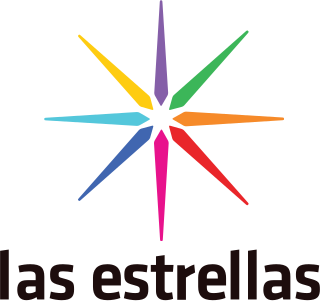Related Research Articles

XHIJ-TDT is a Spanish-language independent station in Ciudad Juárez, Chihuahua, Mexico, serving the Juárez–El Paso–Las Cruces metropolitan area. Owned by Grupo Intermedia and known on air as Canal 44, the station has had a variety of affiliations since signing on the air in 1980 and also produces programs such as local news.
XHDF-TDT, virtual channel 1, is the flagship station of the Azteca Uno television network in Mexico City, Mexico. Azteca Uno can be seen in most major cities in Mexico through TV Azteca's owned-and-operated transmitter network. XHDF provides HD programming to other transmitters and cable and satellite viewers.

XEQ-TDT is a Televisa TV station, based in Mexico City. XEQ is the flagship television station of the Nu9ve network. The Nu9ve network, unlike the other major networks in Mexico, is broadcast by a mix of full-time repeaters as well as local stations, operated by Televisa and its local partners, that also produce and air local programs.

XHGC-TDT is a television station owned by Grupo Televisa, broadcasting from Mexico City, and is the flagship of the Canal 5 network.

Azteca 7 is a Mexican network owned by TV Azteca, with more than 100 main transmitters all over Mexico.
XHGK-TDT is a television station in Tapachula, Chiapas. XHGK broadcasts on virtual channel 13 and is part of the Canal 13 regional network.
XHDY-TDT is a television station broadcasting from its transmitter in San Cristóbal de las Casas, Chiapas and studios in the state capital of Tuxtla Gutiérrez. XHDY broadcasts on virtual channel 13 and is part of the Telsusa regional network.

Las Estrellas is one of the cornerstone networks of TelevisaUnivision, with affiliate stations all over Mexico, flagshipped at XEW-TDT in Mexico City. Many of the programs of Las Estrellas are seen in the United States on Univision, UniMás, and Galavisión.

Foro, is a broadcast news television channel owned by TelevisaUnivision. It is seen on most Mexican cable systems and full-time on two stations in Mexico, including XHTV-TDT in Mexico City, with selected programs airing on Televisa Regional and Televisa local stations. Foro is available on most Mexican cable and fiber-optic systems and the SKY Mexico satellite service, as well as on several national cable systems in the United States.

Canal 5 is a Mexican free-to-air television network owned by TelevisaUnivision. It traces its origins to the foundation of Channel 5 in Mexico City in 1952. Canal 5's program lineup is generally targeted at a younger audience and includes cartoons, foreign series and movies, along with a limited number of sporting events such as NFL games, boxing, the FIFA World Cup and, historically, the Olympic Games.
XHSPR-TDT is a television station in Mexico City, the flagship station for the Sistema Público de Radiodifusión del Estado Mexicano (SPR) transmitter system. It broadcasts on channel 30 from a transmitter atop Cerro del Chiquihuite; its primary signal is the SPR's Canal Catorce network.

The Instituto Mexicano de la Televisión, known commercially as Imevisión after 1985, was a state broadcaster and federal government agency of Mexico. At its height, Imevisión programmed two national networks and additional local stations in Mexico City, Chihuahua, Ciudad Juárez, Guadalajara, Mexicali, Tijuana and Monterrey.
Altzomoni is a volcanic peak located in the State of Mexico. Situated between the volcanoes Popocatépetl and Ixtaccíhuatl in the northern portion of the Paso de Cortés, Altzomoni rises 4,200 metres (13,800 ft) above sea level. It is located inside Izta-Popo Zoquiapan National Park.

Imagen Televisión is a national broadcast television network in Mexico, owned by Grupo Imagen. It launched on October 17, 2016, at 8 p.m.
Canal 13 is a regional broadcasting network operating in parts of Mexico, a division of Albavisión. Its largest subsidiary, Telsusa Televisión México, S.A. de C.V., holds the concessions for 12 TV stations, primarily in southeastern Mexico, obtained in the IFT-6 television station auction of 2017. The Canal 13 network also includes full-fledged TV stations in Villahermosa, San Cristóbal de las Casas—Tuxtla Gutiérrez and Tapachula, as well as their repeaters, and an additional station in Michoacán. All Canal 13 stations are assigned virtual channel 13.
References
- ↑ Instituto Federal de Telecomunicaciones. Infraestructura de Estaciones de TDT. Last modified 2018-05-16. Retrieved 2015-10-18. Technical information from the IFT Coverage Viewer.
- ↑ "Television Fiesta Style", Broadcasting 15 June 1953
- 1 2 1969 concession for XEQ-TV Altzomoni, as obtained from the IFT Public Registry of Concessions, placed in the file for station XHTM-TV; the concession for XHTM-TV Mexico City is likewise placed in the file for station XEQ-TV
- ↑ "XEQ-TV, Powerful", Broadcasting 16 November 1953
- ↑ 1994 "Concession to Operate 62 Commercial Television Stations", as obtained from the IFT Public Registry of Concessions
- ↑ 2010 "Modification of Concession" - specifying digital operation, as obtained from the IFT Public Registry of Concessions
- ↑ RPC: Shadow XHTM Ixtapan de la Sal
- ↑ RPC: Shadow XHTM Tejupilco
- ↑ RPC: Shadow XHTM Tonatico
- ↑ RPC: Shadow XHTM Taxco
- ↑ RPC: Shadow XHTM Pachuca
- ↑ RPC: Shadow XHTM Cuernavaca
- ↑ RPC: #053372 Relocation — Shadow XHTM Ciudad Serdán
- ↑ RPC: Shadow XHTM Huaquechula
- ↑ RPC: Shadow XHTM San Martín Alchichica
- ↑ RPC: Shadow XHTM San Martín Texmelucan
- ↑ RPC: Shadow XHTM Tlaxcala